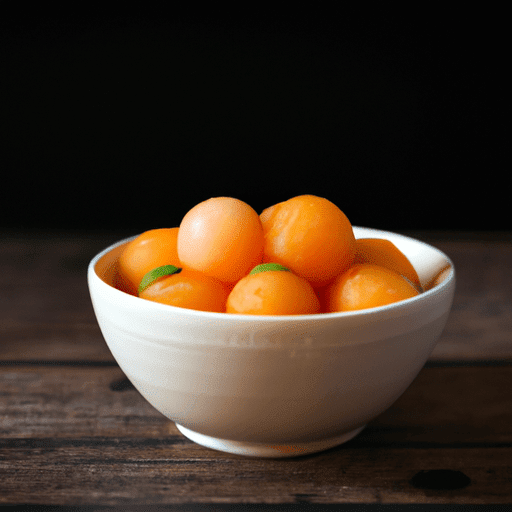Discover the Delight of Cantaloupe Balls: A Refreshing Summertime Treat
If there’s one fruit that embodies the essence of summertime, it’s the juicy and succulent cantaloupe. With its vibrant orange flesh and sweet aroma, cantaloupe is a staple in many households during the warmer months. While there are many ways to enjoy this delicious fruit, one particularly delightful method is to create cantaloupe balls! In this article, we will dive into the world of cantaloupe balls, exploring their taste, common uses in cooking, nutritional value, and some fascinating history and facts.
Taste Profile of Cantaloupe Balls
Cantaloupe balls are small, bite-sized spheres of sheer fruity bliss. Each ball bursts with the essence of cantaloupe, delivering a refreshing and subtly sweet taste. The smooth and velvety texture of the flesh coupled with its melon-like aroma creates a delightful sensory experience. When chilled, these juicy morsels provide the perfect respite on a sweltering summer day, offering a burst of hydration and a hint of tropical indulgence.
Common Uses in Cooking
Cantaloupe balls are versatile and can be used in various culinary creations. Here are a few popular ways to incorporate these delectable fruit balls into your cooking:
1. Fruit Salads: Cantaloupe balls add a vibrant pop of color and a refreshing sweetness to fruit salads. Combine them with other summer fruits like strawberries, blueberries, and watermelon for a burst of fruity goodness.
2. Skewers and Kabobs: Thread cantaloupe balls onto skewers or kabobs alongside grilled meats or vegetables to create a delightful contrast of flavors. The natural sweetness of the cantaloupe pairs beautifully with savory ingredients, offering a harmonious balance.
3. Smoothie Bowls: Top your smoothie bowls with cantaloupe balls to elevate their visual appeal and add a burst of natural sweetness. Not only does it make your bowl look more enticing but it also enhances the flavor profile.
4. Cold Soups: Puree cantaloupe balls with a touch of lime juice and mint leaves to create a refreshing cold soup. Serve it chilled for a light, zesty, and satisfying appetizer on a scorching summer day.
5. Frozen Treats: Freeze cantaloupe balls and enjoy them as a healthy and refreshing frozen treat. These frozen spheres make for a guilt-free alternative to traditional ice creams, offering a burst of natural sweetness without any added sugar.
Nutritional Value
Cantaloupe balls not only tantalize your taste buds but also come packed with essential nutrients. They are low in calories and fat while being rich in fiber, making them a weight-loss-friendly option. Additionally, this fruit is a great source of vitamins A and C, providing a boost to your immune system and promoting healthy skin. Cantaloupe balls also contain potassium, which helps regulate blood pressure and maintain fluid balance in the body.
History and Fun Facts
Cantaloupes have a rich and interesting history dating back thousands of years. They are believed to have originated in ancient Persia and spread throughout Europe and Asia via trade routes. The name “cantaloupe” is derived from the Italian village of Cantalupo, known for its succulent melons. It was in the 18th century that cantaloupes were first introduced to North America.
Interestingly, cantaloupes are part of the muskmelon family and share their botanical classification with other melons like honeydew and casaba. While cantaloupes are commonly known as a summertime fruit, they are available year-round in many regions due to the widespread cultivation and global importation.
Conclusion
Cantaloupe balls offer a delightful and refreshing way to enjoy the flavors of summertime. Whether you incorporate them into salads, skewers, smoothie bowls, cold soups, or frozen treats, their vibrant taste and plethora of culinary possibilities are sure to satisfy your palate. So go ahead, grab some ripe cantaloupes, and create these juicy spheres of bliss to elevate your summer dining experience. Let the spirit of the season infuse your kitchen with the essence of deliciousness!
Cantaloupe Balls
Origin: The cantaloupe, also known as Cucumis melo var. cantalupensis, is believed to have originated in the regions of Persia (now Iran) and India. It was later introduced to Europe by the Romans and has since been widely cultivated in various parts of the world.
Common Uses: Cantaloupe balls are often used as a refreshing and juicy addition to fruit salads, yogurt parfaits, and smoothies. They can also be skewered with other fruits for attractive fruit kebabs. Additionally, cantaloupe balls are commonly used in creating decorative fruit displays and garnishing dessert plates.
Nutritional Benefits: Cantaloupes are a good source of several vitamins and minerals. They are particularly rich in vitamin C, providing more than the daily recommended amount in just one serving. Cantaloupes are also a good source of dietary fiber and contain significant amounts of vitamin A, potassium, and folate.
Unique Properties: Cantaloupes are known for their distinctive sweet aroma and juicy, orange flesh with a mild melon flavor. They have a rough, netted rind that transitions from green to tan as the fruit matures. Cantaloupe balls are usually created using a melon baller, resulting in bite-sized, perfectly round pieces of fruit.
Historical Significance: Cantaloupes have been cultivated for thousands of years and have a history intertwined with various cultures. They were highly valued in Ancient Egypt and were even buried with the pharaohs as a symbol of immortality. In Europe, Queen Elizabeth I of England is said to have been fond of cantaloupes, which contributed to the fruit’s popularity among the upper class. Nowadays, cantaloupes have become a staple summer fruit enjoyed worldwide.




Use the share button below if you liked it.
It makes me smile, when I see it.